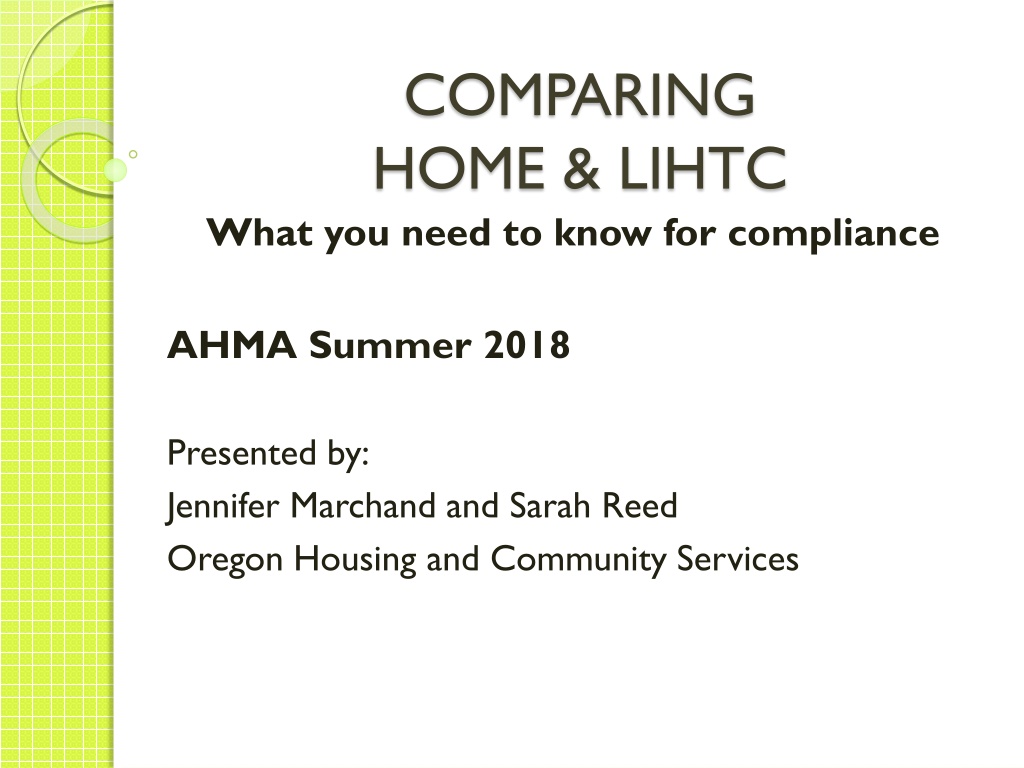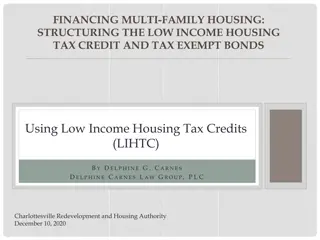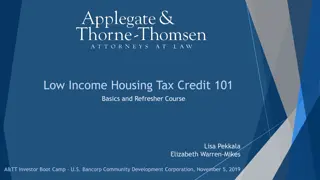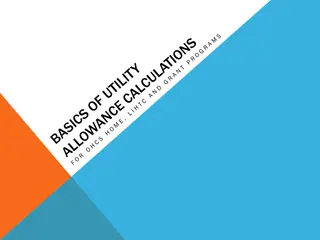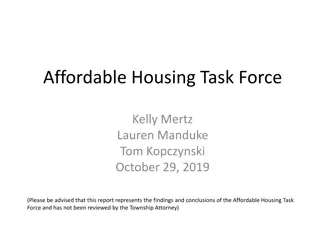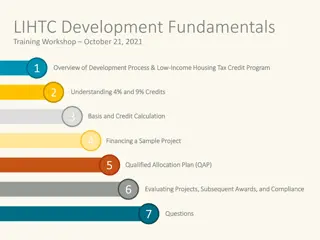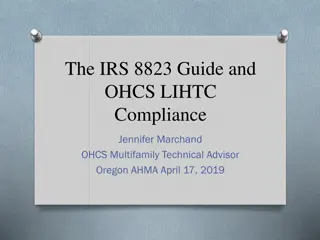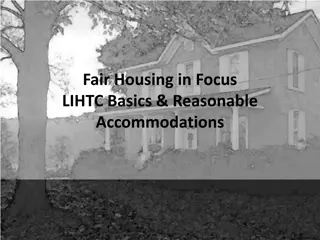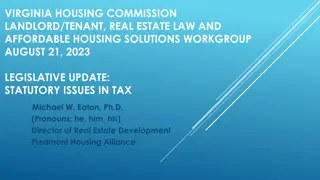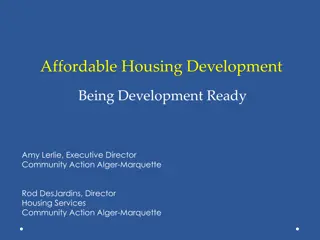Understanding LIHTC and HOME Compliance for Affordable Housing
Learn about the importance of combining LIHTC and HOME programs, key rules for compliance, the 5 Rs of compliance, differences in determining household size, and considerations for selecting the right people for affordable housing projects.
Download Presentation

Please find below an Image/Link to download the presentation.
The content on the website is provided AS IS for your information and personal use only. It may not be sold, licensed, or shared on other websites without obtaining consent from the author. Download presentation by click this link. If you encounter any issues during the download, it is possible that the publisher has removed the file from their server.
E N D
Presentation Transcript
COMPARING HOME & LIHTC What you need to know for compliance AHMA Summer 2018 Presented by: Jennifer Marchand and Sarah Reed Oregon Housing and Community Services
Why LIHTC and HOME Together? Leverage scarce resources Develop mixed income housing Reach a diverse clientele with very low incomes The equity raised from the LIHTC may not be sufficient to provide all of the additional capital required by the project. Often, HOME funds can be used to finance the remaining (or a portion of) the gap
What Program Rule Do I Use? Properties must comply with requirements for both (all) programs This can generally be achieved by following the most restrictive rule (for example third party verification of assets) However, sometimes you must follow multiple sets of rules (for example Student Rule)
The 5 Rs of Compliance Time to add one more R! 1. Right People 2. Right Unit 3. Right Price 4. Right Period of Time 5. Restrictive Rule applies
Right People LIHTC vs. HOME Marketing and AFHMP (Same) Marketing of Accessible Units (Same) Waiting List (Same) Tenant Selection (Generally the Same) Tenant Interviewing (Same) Tenant Qualification (Generally the Same)
Determining Household Size HOME Do not count the following household members when determining household size for the purpose of comparing annual income for the HOME program Live-in Aides Children of Live-in aides Unborn children Children being pursued for legal custody or adoption who are not currently living with the household
Determining Household Size LIHTC Do not count the following household members when determining household size for the purpose of comparing annual income for the LIHTC program Live-in aides Guests IRS allows the following when determining household size for the purpose of comparing annual income for the LIHTC program Unborn children of pregnant women (as self certified) Children who are in the process of being adopted or who are temporarily absent due to placement in foster care
Full Time Students LIHTC Full time student exemptions: At least one student in household must: Receive assistance under Title IV of the Social Security Act (aka: TANF) Previously in State Agency Foster Care Participating in Job Program and receiving assistance (must meet exception such as Workforce Investment Act-JTPA) Single parent with dependent child/children that live with parent at least 50% of time Married and eligible to file a joint tax return
Students HOME Prohibits assistance to individuals who are enrolled in an institution of higher learning from qualifying as a low income family if the individual is under 24 years of age, is not a military veteran, is unmarried, does not have a dependent child, and is not otherwise individually low income or does not have parents who are low income
Right Unit LIHTC vs. HOME Transfers (Different) Maintaining Unit Mix (Different) High and Low (HOME) Different Fixed and Floating (HOME) Different Management Units (Different)
HOME UNIT TRANSFER There is no such thing as a transfer to a HOME unit When a household is moved to a HOME assisted unit, you must complete a HOME TIC using the move-in requirements of third party verification and source documentation. Tenant must qualify for HOME assistance.
LIHTC UNIT TRANSFER 8609 Election is very important! Did they choose Yes or No on Line 8B? Multiple Building Property? Ok to transfer between buildings. Not a Multiple Building Property? Cannot transfer between buildings. Must re-qualify.
High and Low HOME High HOME units are 60% units Low HOME units are 50% units Check the HOME grant agreement for information on your property How many units should be High HOME? How many should be Low HOME? You must know to maintain your unit mix
LIHTC SET-ASIDE Federal Elections on 8609 20/50 Or 40/60 What does REUA or LIHTC Declaration indicate? Most often property is 100% affordable. However, may be mixed income and have market units. Does 140% next available unit rule apply?
Fixed and Floating HOME Fixed Units stay the same Floating Units can float to other units that are comparable in size and amenities Check the HOME grant agreement for information on your property Are your units fixed or floating? You cannot switch back and forth
LIHTC SET-ASIDE SWAP When a lower set-aside unit household has income that increases to the point where they meet a higher set-aside and can afford a higher rent, efforts should be taken to float the lower set-aside (or rent the next available unit) to those who meet the lower set-aside income limit and will benefit from the rent reduction. Tenant Selection policies should indicate the Owner/Agents procedure on how lower set-asides will be designated. Leases should indicate that set-asides may be swapped as applicable when a household s income increases. Even though violations of the more restricted State elected set-aside may not appear to be federal violations, it is common practice among States to report violations as non-compliance with the Reservation and Extended Use agreement. .
LIHTC SET-ASIDE EXAMPLE Example: A property has a federal set-aside of 40@60 however the Owner agreed to provide 100% of the units to tenants who were at or below 60%. Per the REUA ten of the units at the property are designated to be rented to tenants who are at or below 40% of the income limit at rents of 40%. A family who resides in and qualified for one of the 40% units has an increase in annual income (bringing the household to 60% AMI at recertification). This family is now able to pay a higher 60% rent and the lower 40% rent should either be 1. Floated out to an existing household who meets the lower set- aside of 40% 2. Rented to the next household on the waitlist who qualifies at 40%
Maintaining unit mix LIHTC next available unit rule applies if the household income increases over 140% of AMI HOME assistance may need to be reassigned or tenants rent may need to be raised to the limit if household income increases over 80% of AMI Example: Low HOME/LIHTC goes over 50% - float to High HOME High HOME/LIHTC goes over 80% - float to non-HOME and re-designate HOME assistance
Management Units HOME: Employee must qualify and be certified as a HOME assisted resident LIHTC: Employee does not have to qualify Special requirements regarding rent collection Must work FT for the property
Right Price Calculating Rents (Different) Voucher Holders (Different) Rent Increase Requests (Generally Same) Over Charged Rent Correction (Different) Fees (Generally Same) Utility Allowance (Different)
Calculating Rent and Income Limits HUD provides the rents and Income limits on an annual basis for both HOME and LIHTC. HOME- HOME LIMITS LIHTC- MTSP These limits can be found on the OHCS website listed by County Tip: Must compare both and use the most restrictive
RENT INCREASE OHCS approves the rent structure at project lease up and throughout the properties affordability period Rent increase requests must be submitted in writing on OHCS form at least 90 days prior to the planned increase *A rent decrease may be necessary if the rent limits decrease or the cost of utilities increase. TIP: FOR HOME/LIHTC mixed units you must be aware of the different rent and income limits and apply the most restrictive amount
REFUNDING RENTS If it is found that a family is paying over the rent limit, OHCS may require the Owner/Agent to refund the family the amount over-paid going back to the date they were first over-charged If the family is a voucher holder it may be necessary to refund the public housing authority If the PHA does not accept a refund, the money should be put into an account for a resident party or activity Be very aware of the LIHTC consequence for non- compliance when rent is over charged! The unit will be considered out of compliance from the day rent is over charged and for the remainder of the calendar year! Tip: Maintain a Buffer
VOUCHER HOLDERS An applicant cannot be denied for a unit solely because they are a voucher holder Owner/Agents are not allowed to charge rents to tenant based voucher holders that exceed the allowable HOME rents Tenant Paid Rent + PHA subsidy amount + UA must be equal to or less than maximum HOME rent = No exceptions! LIHTC rules are least restrictive for voucher holders but payment standard must be adhered to *It is not acceptable to float HOME assistance away from a tenant if they have a Section 8 voucher so the unit can collect higher rent from the PHA
Fees HOME and LIHTC Non-Optional fees are included in gross rent calculation Nonrefundable fees are not allowed Pet rent is not allowed LIHTC Services must be optional and any charges to low-income tenants for services that are not optional generally must be included in gross rent (Treas. Reg. 1.42-11). A service is optional when the service is not a condition of occupancy and there is a reasonable alternative.
Utility Allowance HOME- Cannot use PHA method for properties funded on or after 8/23/13 LIHTC-Allows several methods including ECM (Energy Consumption Model) LIHTC Project Based UA Rule Building by Building
Right Period of Time Lease Term requirements (Different) Consequences of non-compliance (Generally the Same with 8823 Exception) Lease Termination (Different) Supportive Services (General Same)
LIHTC LEASE TERM All tenants must sign a lease Lease term must be minimum 6 months Non-Transient
HOME LEASE TERM All tenants must sign a lease The lease must show that a one year term was offered The tenant may accept a shorter term The HOME Lease Compliance Form must be used for all HOME tenants, even if they have signed a HOME lease *If another program such as ADF requires a month to month lease, the tenant can accept the month to month option but it must be shown that they were offered a one year lease
LEASE TERMINATION Tenants of HOME-assisted rental units must be provided with 30-day written notice of the owner s intention to evict or deny lease renewal. LIHTC IRS Revenue Procedure 2005 37 prohibits evictions or the termination without good cause of tenancy of an existing tenant of any low income unit throughout the entire commitment period.
SUPPORTIVE SERVICES HOME prohibits Mandatory Supportive Services: Lease terms that require tenant to accept supportive services (with the exception of transitional housing) LIHTC Services must be optional. A service is optional when the service is not a condition of occupancy
Consequences for non-compliance LIHTC Mandatory reporting to IRS via form 8823, may result in tax credit recapture Require replacement of Management Agent Disapprove Owner or Developer for future funding Additional site visits Additional required reporting Require Management or Owner to attend training and become certified Talk with Owner, Investor, and/or Property Manager about site staff concerns
Consequences of Noncompliance HOME Pay Back HOME loan or grant (not pro-rated) Stop and restart affordability clock with non-compliance Require replacement of Management Agent Disapprove Owner or Developer for future funding Additional site visits Additional required reporting Involve HUD and ask for a work-out plan (they will bring everyone to the table including all other lenders) Require Management or Owner to attend training and become certified Talk with Owner, Board, and/or Property Manager about site staff concerns
HOME and LIHTC Mixed Other topics to remember when considering the most restrictive rule: Asset Verification Tenant Certification requirements Compliance Period Lease Provisions
Restrictive Rule Applies What have you learned today? This is a test Which restrictive rule will apply to the following? LIHTC? OR HOME?
Waiting List Which rule is more restrictive? LIHTC? OR HOME?
Unborn Child Which rule is more restrictive for Income limits ? LIHTC? OR HOME? Which rule is more restrictive for Bedroom Size ? LIHTC? OR HOME?
Student Rule Which rule is more restrictive? LIHTC? OR HOME?
Unit Transfers Which rule is more restrictive? LIHTC? OR HOME?
Lease Term Which rule is more restrictive? LIHTC? OR HOME?
Rents and Income Limits Which rule is more restrictive? LIHTC? OR HOME?
Consequences of Non-compliance Which rule is more restrictive? LIHTC? OR HOME?
Utility Allowance Which rule is more restrictive? LIHTC? OR HOME?
Voucher Holders Housing Choice Voucher Which rule is more restrictive? LIHTC? OR HOME? Project Based Voucher Which rule is more restrictive? LIHTC? OR HOME?
Management Units Which rule is more restrictive? LIHTC? OR HOME?
Asset Verification Which rule is more restrictive? LIHTC? OR HOME?
Lease Termination Notice Which rule is more restrictive? LIHTC? OR HOME?
Rent Refunds Which rule is more restrictive? LIHTC? OR HOME?
Tenant Certifications Which rule is more restrictive? LIHTC? OR HOME?
Fair Housing Regulations Which rule is more restrictive? LIHTC? OR HOME?
